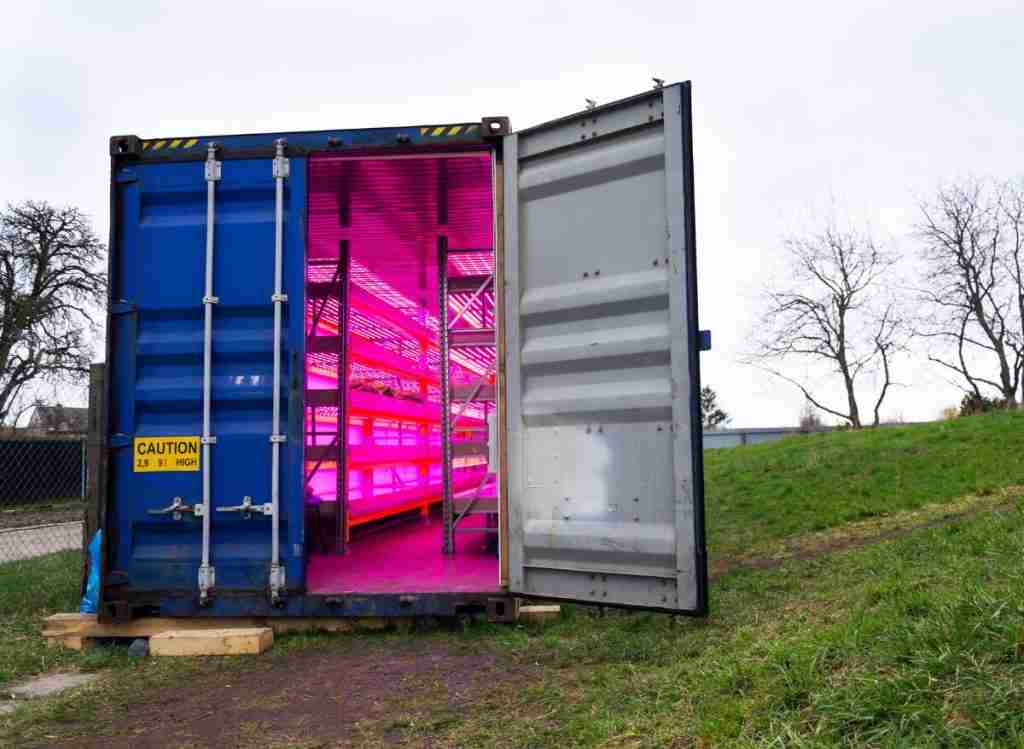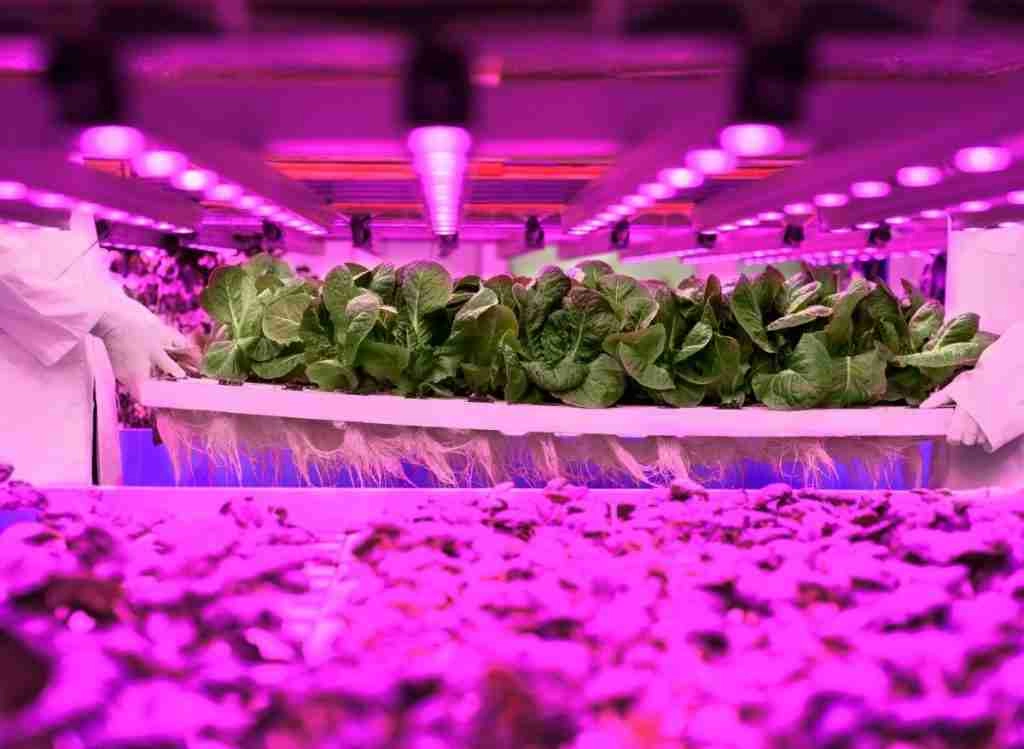
Perhaps you are interested in farming but have been unlucky thus far with your attempts at growing and taking care of plants either on outdoor farmland or in a greenhouse. You may want to try a new type of agriculture called shipping container farms that you heard can make farming easier, but what are shipping container farms?
Shipping container farms are portable micro-ecosystems that optimize the space of a cargo box or shipping container to cultivate crops and other products year-round conveniently. There are many benefits to using shipping container farms over traditional farms and greenhouses.
Keep reading to learn everything there is to know about shipping container farms, including the benefits of using them, what they look like inside, and why farmers may choose this method of farming over any other one.
See also: How Gardening Can Save Money.
What Is the Goal of Using Shipping Container Farms?
Shipping containers are modular, extremely customizable, self-contained, and ideal for housing electrically powered systems. They can be repurposed steel boxes from manufacturing companies or everyday cardboard boxes. The practice falls under the method of controlled environment agriculture.
Ultimately, the goal of shipping container farms is to minimize risk factors that threaten the fullest yield, such as:
- Bad weather conditions
- Pests
- Poor air quality
- Irregular water supply
- Nutrient deficient soil
If you have some money to put towards a green business of your own, investing in a shipping container farm could be a life-changing decision. The containers are incredibly resilient and fully capable of thriving in the middle of an urban setting, in the desert, or even in below-zero temperatures.
Farmers often prove to be an invaluable resource for local communities that may be facing food insecurity or just want more of a variety of food options.
Just to show you their full potential, this article will give you a virtual tour of the more robust container and explain some of the features and details of what maintaining a shipping container farm involves.
See also: The 16 Only Gardening Books You Need
What Does It Look Like Inside a Shipping Container Farm?
A number of factors contribute to the smooth functioning of the farm’s internal systems. Clever use of space and cutting-edge technology are both leveraged to set the shipping container method apart as a super-efficient alternative to traditional field agriculture.
Let’s look at each of these factors below.
Technological Features
One of the most successful shipping container farm companies called Freight Farmers, utilizes sensors to manage air ventilation systems, CO2 tanks, water tanks, and IoT software to afford their operators’ maximum control over their crop growth. The container itself is named The Greenery S.
Cultivation Area
If you were to walk into the central area, you’d see rows of vertical panels stacked one in front of the other in sliding frames. This is the cultivation area where crops that have matured beyond the seedling stage are kept and fed a regular supply of nutrient-enriched water that eliminates the need for soil.
The frames are motor-controlled, using a rack-and-pinion system, moving backward and forwards from LED light arrays that simulate sunlight.
LED Sunlight Simulation
The LED lights reflect different colors of lights to simulate different seasons:
- Red lights mimic the sun of the summer months, stimulating growth hormones in plants.
- Blue lights slow plant growth because they simulate the light of the colder seasons.
An even distribution of these LEDs creates balanced exposure and makes it easier for farmers to keep their crops’ light intake within ranges ideal for optimal photosynthetic processes. Light isn’t the only environmental aspect that requires regulation.
Plant Food Regulation
Sensors feed data to IoT software that the Freight Farmers company calls The Farmhand. It monitors water supply, CO2 levels, and nutrient sources as well. For example, dosing panels deliver the exact amount of water and nutrients directly to each individual plant’s root system, while the ventilation setup reabsorbs evaporation outputs.
The software compares the data against predetermined ratios, pinpoints any performance issues, and then helps the farmer troubleshoot, determining which component to adjust.
Space Management
Taking a closer look at how the space within the container is arranged reveals even more about just how clever the shipping container method really is. There are also stations devoted to different stages of crop growth.
The nursery station is located close to the entryway, with shelved trays of peat moss plugs kept beneath LED lights tailored to the growing needs of budding seedlings. The cultivation area takes advantage of vertical growth and the mobile frame system.
The spatial orientation fits perfectly into the technological systems. Vortex ceiling fans and perforated ducts recycle air to achieve uniform distribution. The ducts are positioned close to the more mature plants to slightly disturb the stems like naturally occurring wind, encouraging the plants to develop some hardiness.
Not to mention, the container itself can be retrofitted with windows, doors, and exterior decoration. There is always the option to make it open to the public so they can get a more intimate picture of the growing process. It’s easily convertible, mobile, and extended.
Why do Farmers Choose the Shipping Container Method?
With the increasing threat of climate change, it’s now more important than ever to turn to more environmentally friendly alternatives for energy use. Shipping container farms massively reduce carbon footprint. It eliminates the need for hundreds of acres.
There’s no need for a lot of real estate or multiple buildings. It’s an all-in-one operation. Automation streamlines all the ins and outs of the complicated growth process.
For those interested in starting their own farm, it’s a lot more straightforward to go through single suppliers like Freight Farmers, CropBox, and Micro Lab Farms. These suppliers train their operators extensively about how to man the helm of all the mechanisms involved.
What Does a Shipping Container Farms Cost?
A pre-made container farm cost is $139,000, plus total start-up costs which depend on the shipment fees, the training package needed, and additional features. You can also buy a pre-made container farm.
Alternatively, a new 40-foot commercial container with no add-on features costs around $4,000 to $8,000. Also, remember that the more features you add, the more the price for a new 40-foot commercial container will increase. Additional costs will include delivery.
Are Shipping Container Farms Profitable?
Even if it requires a high start-up cost, about 50 % of all container farms are profitable. An average acre of soil-farmed land will earn between $20,000 and $30,000 per year, while an average acre of hydroponically grown crops will earn between $200,000 and $250,000 per year, according to the University of Florida.
Leafy greens such as lettuce are the most profitable crops to grow in shipping container farms because they have the lowest operation costs. Leafy greens yield an average 46 percent profit margin and have one of the lowest operational costs, about $20/sq.

Hydroponic Shipping Container Farms
Generally, hydroponics is the method used to grow plants inside container farms. Hydroponics is an alternative growing method that grows plants without the use of soil. Instead, you submerge the plants’ roots in nutrient-rich water, providing them with all the nourishment they need.
You can learn all about the 6 different types of hydroponics and also the differences between hydroponics and soil gardening, including their pros and cons.
Here are the different types of hydroponics systems that you use in shipping container farms
- Aeroponics
- Drip System Hydroponics
- Wick System Hydroponics
- Deep Water Culture (DWC)
- Nutrient Film Technique (NFT)
- Ebb and Flow System
What Can be Grown In Shipping Container Farms?
There is a wide range of cops you can grow in container farms. In general, lettuce is the most common and easiest crop to grow in container farms.
The table below summarizes all the plants that you can grow in shipping container farms.
| Plants Grown In Shipping Container Farms | Variety |
| Lettuces | – Romaine – Leaf – Bibb – Butterhead |
| Leafy Greens | – Asian Greens – Arugula – Collard Greens |
| Herbs | – Thyme – Sage – Parsley – Dill – Basil – Chives |
| Flowers | – Calendula – Viola – Celosia – Zinnia – Nasturtium – Yarrow – Nigella |
| Roots | – Beets – Bunching Onions – Carrots – Kohlrabi – Radishes – Turnips |
In Conclusion
This sustainable method of crop agriculture affords local communities the ability to produce year-round with minimal inconvenience to the farmer. With IoT software doing most of the work, farmers can supervise remotely.
Traditional agriculture is becoming a less attractive industry for upcoming generations, but with the coupling of technology and space innovation, more aspiring entrepreneurs could be attracted to the investment in years to come.

